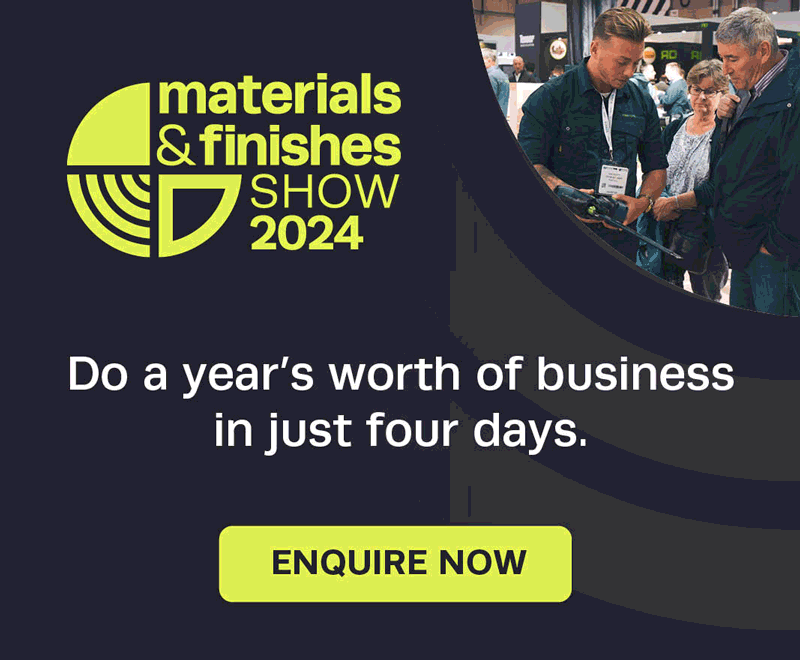This year’s Cersaie took place in an interesting context. While 2022 saw the ceramics industry, and Italian tile manufacturers in particular, emerge stronger than ever from the lockdown era, registering record revenues, 2023 has thus far been a much more challenging affair. Many global political and economic trends have contributed to what Maurizio Forte, the recently appointed director general of the Italian Trade Agency ITA described as a “year of uncertainty,” but the end result is that the 40th anniversary edition of Italy’s premier tile fair proceeded with a little less straightforward celebration than the industry might have hoped.
Of course, it’s only in response to difficult times that the industry can truly put its technical skill and ingenuity to the test. Rather than a moment to rest on their laurels or take a victory lap, then, tile companies treated Cersaie 2023 as a platform to reaffirm and re-establish all the exceptional and versatile qualities of porcelain, making a fresh case for the sector at large.
While some of the especially out-there impulses of last year’s show have therefore been reined back, designers were able to display a more considered creativity this year. On many stands, manufacturers displayed their most adventurous concepts directly alongside traditional designs, demonstrating the ability of tile to fit any location no matter how varied.
Similarly, the explosion of porcelain’s technical capabilities, from slip resistance to antibacterial technology, illustrated the material’s suitability to nearly any task. Finally, the full re-emergence of sustainability as a vital theme for manufacturers – after it took something of a backseat during the pandemic era – positioned ceramics as a material not just with a long and storied past, but one with a vibrant, resilient future too.
Certainly, it would have been more convenient if Cersaie’s 40th anniversary celebration took place in the tile industry’s most profitable year ever. As we know, however (particularly here in the UK!) things rarely line up so neatly. Instead, the 2023 show, aptly themed “Route 40,” found the industry in motion, taking stock of its successes and lessons over the past four decades but never stopping. Whether the show will mark “a turning point” for international trends, as Forte suggested at the show’s press conference, remains to be seen, but one thing is certain. The route doesn’t end here.
Slower, but steadier
As always, that press conference, which took place following the show’s first day, provided valuable background and industry updates for journalists. Emilio Mussini, vice chairman of Confindustria Ceramica, discussed the exceptional performance of the industry in 2022 and how that has transitioned into a slower start to 2023. “Last year’s revenues exceeded €7 billion, an increase of 16.5% over 2021,” he said. “Italy remains the world leader in terms 4
of market share at 29%, well ahead of China’s 19% and Spain’s 18%. India saw considerable growth, reaching a 7% market share. Our sales fell by 14.4% in the first half of the current year, reflecting a slowdown in global markets.”
In addition to the global slowdown, the ceramics industry – the Italian ceramics sector in particular – has embraced further challenge by committing steadfastly to its sustainability targets. Director general of Confindustria Ceramica, Armando Cafiero, pointed out that “The air quality in the Sassuolo ceramic district is now superior to that of neighbouring cities,” demonstrating the industry’s long-term commitment to lowering emissions over the past several decades.
The 2020s are proving to be a moment of transition for the industry, as research into viable alternative energy sources necessarily intensifies. Cafiero spoke about this challenge: “Natural gas will continue to be the best fuel for managing the energy transition. Research is underway to find alternative energy sources such as hydrogen, which while being technically feasible currently face insurmountable economic difficulties. Research efforts are also focusing on carbon capture and storage, for which purpose collaboration is underway with Eni, Snam and the Emilia-Romagna regional government to create a storage site in Ravenna.”
Marking its continued commitment to this research and the values underpinning it, Confindustria Ceramica also chose the occasion of Cersaie to launch a new communications campaign around its sustainability efforts. The campaign consists of eight postcards, each focused around a particular aspect of sustainability in relation to Italian ceramics, such as their lifespan compared to production times, or the industry’s use of energy cogeneration and photovoltaics. Each theme is shown on a postcard in what’s described as an “elegant, vintage look reminiscent of iconic Italian advertising illustrations,” and addressed from “the ceramics sustainability capital of the world”.
While these sustainability commitments are not made unilaterally across the industry, the Italian sector is convinced that prioritising the health and longevity of its environment is a more important goal than producing and selling the maximum square metres of tiles possible for the next 12 months. And certainly, it’s hard to deny that a tile industry that lasts will ultimately be more profitable than one that wantonly burns through non-renewable fuels or fails to prepare for stricter requirements in the future.
Natural fashions
Many of the styles present at this year’s show were continuous with last year’s trends. Stone- and wood-effects, for example, as well as floral wallpapers and block colours, returned in full force, although designs appeared slightly more neutral this time around. Undeniably, luxurious, opulent and extroverted surfaces popped up throughout the exhibition – particularly at the more technologically-focused stands – however the overall impression was one of muted sophistication.
Indeed, it could be said that neutral stone looks dominated the show, with an example at seemingly every stand. From Pamesa’s Aroa and Duplostone ranges, to Gayafores’ Savana collection, to Cerrad’s Everlasting line, each manufacturer has taken a subtly different approach to the clearly timeless trend. Aparici’s Bavaria line, for example, borrows the “unmistakable” appearance of the region’s stone, featuring fern-like and coral-like dendrites. While these stone looks aren’t always the most exciting products on show, they remain popular for good reason, playing an unassuming yet dignified supporting role in a huge variety of interior schemes.
Wood designs also saw a refresh, with simple, natural effects winning out again. Baldocer showcased its cool-toned Vermont series, while Sichenia Ceramica presented its P_arkett collection, for which the company researched in Austria to find what it calls “the most natural oak wood essences”. At its stand, the company highlighted how this range could be laid in a herringbone pattern alongside white and gold marble-effects to create a luxurious interior, contrasting the material’s traditionally humble reputation. Casalgrande Padana also presented its latest range in this category: Project Wood, which imitates European beech in two plank formats, a 9mm thick 20x120cm variant and a 20mm, 40x120cm format which features an anti-slip finish for outdoor use.
While none of these designs are likely to surprise visually, the quality of their reproduction becomes more impressive each year, with several manufacturers’ offerings appearing near indistinguishable from the real thing until you get very close indeed. Moreover, the technical qualities of porcelain often make these tiles a superior choice to their natural counterparts, particularly with respect to their environmental performance, requiring significantly less maintenance while avoiding harmful deforestation.
More than skin-deep
Of course, Cersaie is also a platform for novelty, whimsy and daring, and designers certainly took the chance to flex their muscles in 2023. Wallpaper-like designs with unusual geometric patterns, Art Deco inspired visuals and crackled glazes made their way onto several of the stands at this year’s show, with the triple- and quadruple-fired glazes seen at this year’s Cevisama exhibition remaining very much in vogue for the Italian show.
In collaboration with the Zaha Hadid Architects firm, the marble-effect Marvel Meraviglia collection from Atlas Concorde was presented in a series of monochromatic diamonds to create the impression of 3D cubes across the wall. According to Paolo Zilli, associate director at the architecture firm, this diamond décor “contaminates a classic mosaic with a disrupting element” and creates “unsuspecting dynamism”. Panaria Ceramica devoted one wall of its stand to an enormous array of unique designs across a set of small-format hexagons, with a plainer grey backdrop to create a sense of contrast. This display boasted a dual purpose of showing an incredible variance of designs to choose from, but also how these designs can be used together, or as highlights on an otherwise plain surface.
With ever-increasing capabilities to explore depth of colour, many manufacturers made use of stark, clean lines in their collections, evoking various artistic traditions from Japanese kintsugi to geometric Victorian tiling. Revigres’ Cromatica 3.0 collection offers a pared down (although still impressive!) range of 30 shades which feature “pure and saturated colours, with different degrees of luminosity and intensity”.
Taking cues from the world of fashion, designers continue to experiment with a range of effects inspired by metal. Unlike the shimmering, attention-grabbing designs seen on many of 2023’s garments however, the metal-effect tiles on display at Cersaie were more concerned with the material’s mutable qualities. Tagina’s straightforwardly named Metal collection, for example, is a showcase of “corrosion and oxidisation,” showing how materials can become even more beautiful for being tarnished by nature. Concept 1 from Gigacer, on the other hand, presents what almost appears to be a parody of industrial metal surfaces – a jumble of textures and reliefs altogether removed from their originally useful contexts.
Even among these artistic selections though, a sense of maturity won out, with even the most exciting collections feeling reasonably usable. To aid this idea, many manufacturers presented their products on mood board displays, positioned alongside other design elements to showcase how an interior theme could be developed.
Everything in its right place
Size and shape continue to prove just as fertile ground for creativity in tile design as the surfaces themselves, with companies innovating in every direction and dimension. While the upper limit of scale seems to have settled around the 160x320cm mark for the time being, it was fascinating to see how many variations manufacturers were able to explore within that limit. Half-moons, fish scales, feathers, planks, bricks, all manner of geometric configurations, not to mention a huge variety of reliefs creating both concave and convex effects – it’s perhaps quicker to list shapes that tiles weren’t shown in!
Particularly appealing were Equipe’s Porto tiles, inspired by the charming city of the same name, which create an interlocking, puzzle-like effect when laid together. The Deco Lingot series from Gayafores, on the other hand, uses straight lines incorporated into a rectangular grid pattern to simulate lattices or grids. As always, most intriguing were the areas in which standard squares or rectangles were showcased directly alongside their more unusual cousins, demonstrating the usability of design-led tiles even in relatively conservative environments.
The work continues…
Although 40 is a nice, round number, it is by no means an endpoint. With Cersaie once again exceeding 100,000 visitors this year after its pandemic-enforced pause and restart, the show appears as vital to the industry’s continued growth as ever. Particularly in this era of challenge and disruption, the exhibition makes for a solid patch of ground for companies to plant their feet and assure customers: we’re not going anywhere.
While visual designs tended towards the sensible rather than bombastic this year, the industry’s collective focus on sustainability has never been more ambitious. Nearly every company’s stand featured some reference to their environmental initiatives and commitments, as good a sign as any that the sector is planning for a long future. And with research into sustainability, aesthetics and technical capabilities advancing year-on-year, that long future seems all but assured – provided the industry maintains the diligence and conscience it has demonstrated to this point.
Perhaps the victory lap can wait for Cersaie 50!
www.cersaie.it/en









